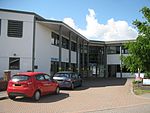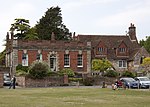Salisbury railway station
DfT Category C1 stationsEngvarB from October 2013Former Great Western Railway stationsFormer London and South Western Railway stationsGrade II listed railway stations ... and 6 more
Pages with no open date in Infobox stationRailway stations in Great Britain opened in 1859Railway stations in WiltshireRailway stations served by Great Western RailwayRailway stations served by South Western RailwaySalisbury

Salisbury railway station serves the cathedral city of Salisbury in Wiltshire, England. It is 83 miles 43 chains (134.4 km) from London Waterloo on the West of England line to Exeter St Davids. This is crossed by the Wessex Main Line from Bristol Temple Meads to Southampton Central. The station is operated and served by South Western Railway (SWR), and is also served by Great Western Railway (GWR).
Excerpt from the Wikipedia article Salisbury railway station (License: CC BY-SA 3.0, Authors, Images).Salisbury railway station
Churchfields Road, Salisbury Churchfields
Geographical coordinates (GPS) Address Nearby Places Show on map
Geographical coordinates (GPS)
| Latitude | Longitude |
|---|---|
| N 51.0705 ° | E -1.8055 ° |
Address
Churchfields Road
SP2 7NL Salisbury, Churchfields
England, United Kingdom
Open on Google Maps










